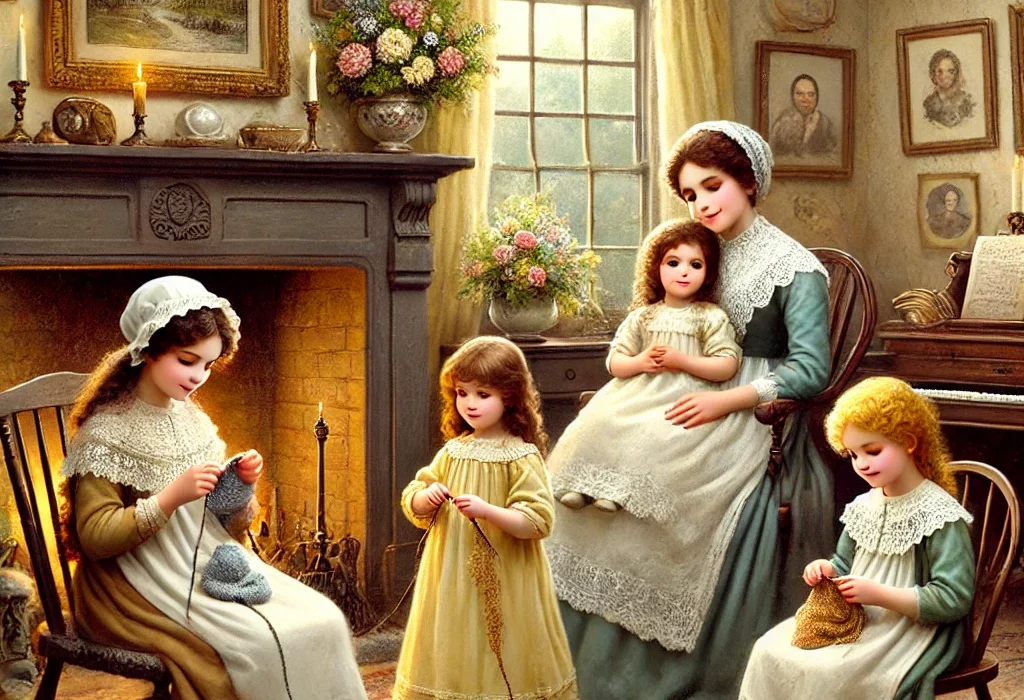Little Women, first published in 1868, is one of the most beloved works by Louisa May Alcott. The story is loosely based on Alcott’s own life, particularly her experiences growing up with her three sisters in a modest household. Set during the American Civil War, the novel follows the lives of the four March sisters—Meg, Jo, Beth, and Amy—as they navigate the challenges of adolescence, family struggles, and their personal dreams. With its intimate depiction of family life, friendship, and individual aspirations, Little Women has remained an enduring classic, cherished for its warm portrayal of sisterhood and its exploration of women’s roles in society.
Plot Summary
On a chilly Christmas Eve, four sisters—Meg, Jo, Beth, and Amy March—gather in their modest home, lamenting their family’s poverty. With their father away serving as a chaplain in the war, the girls and their mother, Marmee, face daily challenges, but they find comfort in each other’s company. Though disappointed by the lack of Christmas presents, the girls decide to embrace the spirit of giving. With their own money, they buy gifts for Marmee instead of for themselves. As they sit together, Marmee brings a letter from their father, expressing his love and pride, which strengthens their resolve to face their struggles with courage.
Each of the sisters has a unique personality and dreams of a different future. Meg, the eldest, longs for a life of comfort and luxury, away from her duties as a governess. Jo, headstrong and rebellious, despises the constraints of being a woman, dreaming of becoming a writer and living a life of adventure. Beth, the quiet and gentle heart of the family, finds contentment in caring for her home and playing the piano. Amy, the youngest, is an ambitious artist, often consumed by her desire to surround herself with beauty and refinement.
Their lives are simple, but filled with small joys and trials. They put on plays together, share their secrets, and lean on one another through the ups and downs of life. Jo befriends their wealthy, lonely neighbor, Theodore “Laurie” Laurence, whose mischief and warmth bring the sisters much delight. Laurie becomes part of their circle, growing particularly close to Jo, though his affection for her deepens into something more than friendship.
As time passes, each of the March sisters faces their own journey of growth. Meg attends a high-society party, where she is dazzled by the luxury she envies. However, she realizes that true happiness cannot be bought when she marries John Brooke, Laurie’s tutor, a humble man of modest means. Their love is simple and sincere, and though Meg struggles to adjust to her new life, she learns that love and patience are worth more than riches.
Jo, ever the free spirit, continues her writing and refuses to conform to society’s expectations. When Laurie eventually confesses his love for her, Jo is heartbroken to turn him down. She sees him as a dear friend but cannot imagine a romantic future with him. Hurt by her rejection, Laurie leaves to travel abroad, seeking solace in Europe. Jo, meanwhile, moves to New York City to pursue her writing career, where she meets Professor Friedrich Bhaer, a kind, intellectual man who challenges her views on life and literature. Though Jo is slow to recognize her feelings, their friendship deepens into a quiet, steadfast love.
Back home, Beth’s health deteriorates after she contracts scarlet fever. Her delicate nature, always prone to illness, weakens further as time goes on. Though her family surrounds her with love and care, Beth knows that her time is limited. She accepts her fate with grace, focusing on bringing comfort to her loved ones. Her peaceful death leaves the family devastated, especially Jo, who had always been closest to her. Beth’s passing marks a turning point for Jo, who channels her grief into her writing, finding solace in her creative expression.
Amy, meanwhile, accompanies their wealthy Aunt March on a trip to Europe, fulfilling her long-held dream of visiting the great cities of art and culture. In Europe, she crosses paths with Laurie, who is still nursing his heartbreak over Jo. Through their shared experiences abroad, Laurie’s feelings for Amy blossom into genuine love. Amy, having matured into a thoughtful and graceful woman, no longer cares for wealth or status as she once did. She and Laurie marry, returning home as a united and loving couple.
In the end, Jo returns to her family, having grown from a restless dreamer into a more grounded woman. With Beth’s death still weighing on her heart, she decides to honor her memory by opening a school for boys, using her childhood home as the setting for this new chapter of her life. Jo marries Professor Bhaer, finding a partner who shares her values and respects her independence. Together, they embrace the joys and challenges of their unconventional family life.
As the years pass, the March sisters continue to support each other through the joys and hardships of life. Meg finds contentment in her role as a mother and wife, Amy flourishes as a painter and devoted partner to Laurie, and Jo finds fulfillment in her work and in the family she creates. Though they all faced different paths, their bond as sisters remains strong, shaped by the love and lessons they learned from their beloved mother, Marmee.
The story concludes with Jo reflecting on the journeys they have taken. Though life has not turned out as any of them had expected, each sister finds happiness and purpose in her own way. The March family’s love and resilience carry them through, and their cherished memories of home become the foundation of their lives.
Main Characters
Meg March (Margaret): The eldest of the March sisters, Meg is a caring, maternal figure who strives to embody the ideals of a perfect domestic woman. She is sensible and nurturing, often serving as a second mother to her younger sisters. Meg dreams of marrying well and living a comfortable, traditional life, but she learns the value of love and sacrifice when she marries John Brooke, a modest tutor, and embraces a simpler life.
Jo March (Josephine): Jo is the fiercely independent and tomboyish second sister, passionate about writing and determined to carve her own path. She rejects traditional expectations of femininity and yearns for a life of adventure and creativity. Jo’s fiery temper, ambition, and struggle between personal desires and family duty make her one of the most complex and beloved characters in the novel. Her journey centers on finding balance between independence and affection for those she loves.
Beth March (Elizabeth): Beth is the shy, gentle, and selfless sister, often described as the moral center of the family. She prefers the comfort of home and finds joy in simple tasks such as playing the piano and caring for others. Throughout the story, Beth’s quiet strength and generosity influence her sisters profoundly. Her battle with illness becomes a poignant moment in the novel, emphasizing themes of loss, love, and resilience.
Amy March: The youngest March sister, Amy is artistic, ambitious, and sometimes vain. She dreams of a life filled with beauty and sophistication. Amy matures significantly over the course of the novel, evolving from a somewhat spoiled child into a graceful, poised woman who finds happiness in both love and personal growth. Her relationship with Laurie, Jo’s best friend, becomes one of the significant romantic arcs in the story.
Marmee (Mrs. March): The girls’ mother, Marmee, is the moral compass of the family. Her wisdom, patience, and strength guide the sisters through their personal struggles and challenges. She teaches them the value of charity, kindness, and inner strength, often encouraging them to face their hardships with grace.
Laurie Laurence (Theodore Laurence): Laurie is the charming and wealthy neighbor of the March family. He forms a deep friendship with Jo but later develops romantic feelings for her, which she does not return. Laurie’s character evolves through heartbreak and maturity, and he eventually marries Amy, with whom he finds true companionship and love.
Theme
Family and Sisterhood: The core of Little Women is the bond between the March sisters and their relationship with their parents, especially their mother. Family loyalty, love, and support are central to the novel, and much of the story’s heart comes from the way the sisters navigate life’s challenges together. Their individual personalities and ambitions clash and complement each other, demonstrating the complexities of familial relationships.
Female Independence and Identity: One of the novel’s most significant themes is the quest for female independence, particularly through Jo’s character. She struggles with societal expectations that dictate women should marry and be confined to domestic roles. Her refusal to conform and her pursuit of a writing career highlight the tension between personal ambition and societal norms. The novel explores how each sister defines her own path to independence, whether through career, marriage, or self-fulfillment.
Poverty and Wealth: The contrast between the March family’s modest lifestyle and the wealthier families around them, like the Laurences, reflects the theme of poverty versus wealth. The sisters often grapple with feelings of envy, but the novel emphasizes the importance of character and virtue over material wealth. Alcott uses this theme to critique society’s obsession with status and riches, instead promoting a message of personal contentment and moral richness.
Love and Marriage: Little Women portrays different types of love and relationships. Each sister’s romantic journey is distinct, reflecting various attitudes toward marriage. Meg marries for love despite financial difficulties, Jo initially rejects the idea of marriage in favor of independence, Amy finds love with Laurie after initially pursuing wealth, and Beth remains the embodiment of selfless familial love. The novel suggests that love, in its various forms, must be genuine and aligned with individual values.
Personal Growth and Sacrifice: The March sisters undergo significant personal growth, each learning valuable lessons about sacrifice, duty, and selflessness. Jo learns to temper her ambition with love for her family, Meg embraces the realities of married life, Amy matures from vanity to grace, and Beth quietly embodies sacrifice through her gentle care for others and her acceptance of mortality.
Writing Style and Tone
Louisa May Alcott’s writing style in Little Women is characterized by its warmth, simplicity, and moral clarity. She uses a straightforward, conversational tone that invites readers into the intimate world of the March family, making their joys and sorrows feel personal and relatable. Alcott often infuses the narrative with a didactic quality, reflecting her intention to teach moral lessons through the experiences of the characters. Despite this, the story never feels overly preachy; instead, the lessons are woven naturally into the characters’ lives and choices, especially as conveyed through Marmee’s wisdom.
Alcott’s narrative style is often light-hearted, filled with humor, particularly in Jo’s antics and the sisters’ lively conversations. At the same time, the tone shifts to a more solemn and reflective mood during moments of hardship, such as Beth’s illness or the family’s financial struggles. The balance between these tones creates a realistic portrayal of life’s highs and lows. Additionally, Alcott’s use of vivid descriptions brings the domestic setting to life, from the cozy warmth of the March home to the bustling streets of New England.
We hope this summary has sparked your interest and would appreciate you following Celsius 233 on social media:
There’s a treasure trove of other fascinating book summaries waiting for you. Check out our collection of stories that inspire, thrill, and provoke thought, just like this one by checking out the Book Shelf or the Library
Remember, while our summaries capture the essence, they can never replace the full experience of reading the book. If this summary intrigued you, consider diving into the complete story – buy the book and immerse yourself in the author’s original work.
If you want to request a book summary, click here.
When Saurabh is not working/watching football/reading books/traveling, you can reach him via Twitter/X, LinkedIn, or Threads
Restart reading!








